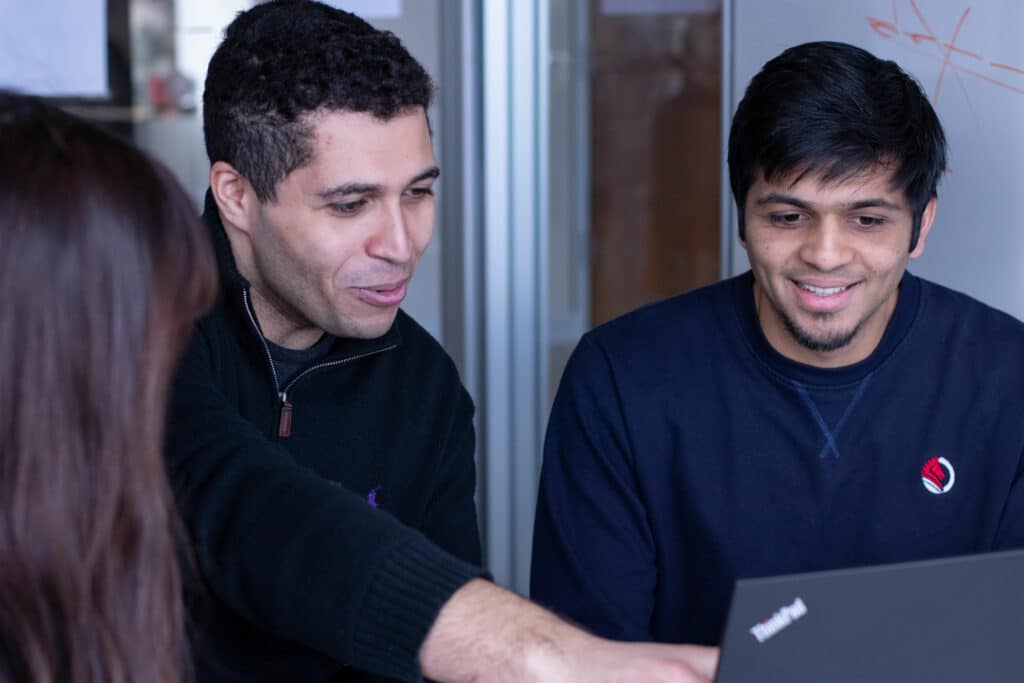Scour job descriptions or work on a team long enough, and you’ll inevitably encounter the words “team player.” It’s an universally lauded skill, of course, but it’s also a phrase that means different things depending on who you ask.
That’s not to say there aren’t common trends all great collaborators share. Whether you’re a tenured employee or gearing up for your next opportunity, it helps to brush up on your fundamentals. In this blog, we’ll explore five traits that make an ideal team player.
Here’s what we’ll cover:
- What does it mean to be a team player in the workplace?
- What qualities make a good team player at work?
- What are examples of collaborative teamwork skills?
Ready? Let’s dive right in.
What is a Team Player?
A team player is an individual who works well within a group, prioritizing the collective goals of the team over personal ambitions. They actively collaborate, communicate effectively, and support their colleagues, fostering a positive and productive team environment.
Key qualities of a team player include reliability, adaptability, and a willingness to share knowledge and skills to help the team succeed. Being a team player is essential for achieving synergy and driving the overall success of projects and organizational objectives.
A personalized leadership approach for each team member.
PI’s behavioral insights help leaders inspire and coach each employee in a way they truly connect with.
What does it mean to be a great team player in the workplace?
At its core, being a team player means being ready, willing, and able to support the team—no matter what lies ahead.
In sports, the high-performing team players are the ones who act unselfishly and make decisions for the good of the team. LeBron James may be the best player on the basketball court at any given moment. But if the clock’s ticking and he spots an open teammate, he’ll pass the ball.
The same principles apply in a workplace setting. As an individual contributor, it can be tempting to make decisions based solely on your own needs. Maybe you enjoy doing certain tasks over others, or feel there’s more career “potential” being on Project A than Project B.
While these needs shouldn’t be discounted, they shouldn’t be the end-all, be-all either. In a team setting, it’s important to understand not just your needs, but also those of your fellow collaborators. When weighing decisions, ask yourself questions like:
- Does the work I’m doing further the team’s common goals?
- Are there other areas where the team needs my expertise?
- If I don’t do this, will it cause problems for others?
- What can I do to better help the team succeed?
A great team player is constantly walking that line between the self and the group. To them, public recognition is satisfying, but so is sharing that spotlight with the entire team. And, like the best athletes, they tend to elevate those around them—and help them thrive.

What qualities make a good team player at work?
There are many hallmarks of a good team player, but the most pertinent traits tie back to supporting and facilitating. The more you can do to build people up and make their work easier, the more cohesive the team will be. And that can pay off in terms of productivity and results.
Here are five characteristics that make an effective team player:
1. Flexibility
Collaboration is all about compromise—and flexibility. When presented with difficult timetables or deliverables, try to meet your peers halfway. Start a dialogue about what’s reasonable and what’s not, and do your best to accommodate their needs.
Flexibility doesn’t mean bending over backwards, granted. In a team environment, it’s important that everyone do their fair share and strive for quality work. Don’t be afraid to push back where you see missed responsibilities or poor accountability. But always come from a place of good intent, and assume the same of your teammates.
2. Active listening
Collaboration often evokes feelings of sociability and shared ideas. While that’s certainly accurate, it’s equally important to take time to listen and reflect.
Make sure you’re putting as much energy into other people’s ideas as you do your own. If you catch yourself talking for the majority of a team meeting, cede the floor to those who haven’t spoken. Invite those who might normally feel intimidated to share their thoughts.
When listening to your peers, let them see you’re engaged. Make eye contact, and keep the body language positive (e.g., smiling, nodding). By being an active listener, you show others you value their input. Not only does this build trust; it also encourages innovation and creativity.
3. Problem-solving
Collaborating also means being able to think critically and solve issues when they arise. While problem-solving often pertains to projects or tasks, it also applies to people.
A strong team player doubles as a great intermediator in times of conflict. When team members aren’t seeing eye to eye on a certain project, put your active listening to good use. Consider the different sides of the argument, and try to be impartial and respective of all points of view.
Remind your peers that you’re all working toward the same goals. By establishing good intent from all parties, you can ensure conflict that’s constructive, rather than detrimental. And that’ll help the team work toward a healthier resolution.
4. Effective communication
To be a strong team facilitator, you also need good communication skills. And that starts with a thorough understanding of your coworkers’ and teammates’ natural behavioral tendencies.
Say you’re highly extraverted and informal. If your peers carry themselves similarly, the best way to communicate may be with a group meeting or impromptu Slack thread. But if people are more reserved or rather formal, you may get better results with 1-on-1 conversations or emails.
In short, share information in a way that fits your teammates’ needs. And strive to do so while being honest and transparent.
5. Positive attitude
While not a technical skill, positivity can be instrumental when looking to become a better team player. Think of it as the hidden x-factor you can leverage anytime, anywhere.
Bring energy and enthusiasm to every team meeting. Offer help to your colleagues where you see an opportunity. Find new ways to collaborate with and learn from one another. Above all, celebrate your team’s successes—and encourage everyone to accept failure with grace.
By maintaining that positivity, you can help break down walls that hinder communication and stifle collaboration. Teammates may feel more comfortable bringing ideas to you or seeking your support. And in turn, they may be more willing to lend a hand when you need it most.

What are examples of collaborative teamwork skills?
When looking to be part of a dream team, it helps to have examples of past collaborations well worth emulating.
In sports, an obvious choice would be the U.S. women’s national soccer team. Not only has the group won the Women’s World Cup a record four times, but it’s also only the second team to win back-to-back titles (2015 and 2019). If there’s a paragon of teamwork out there, it’s this one.
Another great candidate is the 1992 U.S. men’s Olympic basketball team, or “Dream Team.” This team made history for being the first Olympic team to include NBA players. Perhaps more importantly, it’s remembered fondly for its unquestionable talent and extraordinary cohesion.
In the business world, look at the teams at Apple and Microsoft, who forever changed the way we communicate. Or, leave the world altogether and think of the Apollo 11 launch, which saw astronauts Neil Armstrong and Buzz Aldrin land on the Moon.
No team is built the same, but in each of these cases, the results were a joint effort. Just as you don’t reach the Moon or Olympic finals by yourself, you can’t expect to go far on a team unless you work as a cohesive whole.
Discover new opportunities for successful team collaboration.
By putting all of the above to action, you can ensure teamwork that’s organic and genuine. But achieving this takes time—not to mention continual self-improvement.
When in doubt, keep your team’s needs in mind. First, consider the group’s strategic goals. Then think about the people who make up your team—their personalities and behaviors—and where you fit into the mix. By understanding how these pieces fit together, you can identify ways to strengthen cohesion and find areas to better collaborate.
Having data on hand makes this easier. PI’s Team Discovery tool can help you see you, your team, and your strategy at a glance. Use the tool to see your Team Type, or the collective behavioral makeup of your team. From there, learn where your strengths lie as a group—and where there are gaps relative to the goals you’re pursuing.
Whether you’re an Exploring Team focused on innovation, a Stabilizing Team focused on building efficiencies, or something else entirely, there are always opportunities to collaborate as a team. Find your identity, embrace your strengths, and strive to make each workday smoother than the last.
Like the very best in sports, be a team player, and you’ll have your goals within sight soon enough.
Strategies for becoming a better team player
There’s no one-size-fits-all method for becoming a better team plater, but there are some simple, tried-and-true tactics for sharpening your teamwork traits. You can strive to:
Identify strengths and weaknesses.
Behavioral data supports this sort of self-awareness. PI’s Behavioral Assessment helps you better understand your strongest drives, and how they might show up in the workplace. Understanding your Reference Profile also allows you to see which behaviors are less pronounced, and where you might need to stretch to fit the demands of a given role.
Build positive relationships with teammates.
The same behavioral awareness can be applied at the peer and team levels, as well. Understanding a colleague’s strongest natural behaviors can help you communicate and work better with them, providing the foundation for a productive professional relationship. Visualizing these behaviors at the team level helps you understand group dynamics, and anticipate where your team may clash, struggle or stall out.
Be open to learning new things.
Having a learning mindset generally makes you a better teammate. Your peers will notice your desire for development. In turn, they will trust you enough to ask for your help, and they’ll value your input, even on matters or projects that might be beyond the defined scope of your role. Learning new skills, or familiarizing yourself with new tools, also makes you more attractive for promotions, raises, or new responsibilities.
Respect different ideas and perspectives.
Trust is foundational to any functioning team, but you can’t gain trust in your teammates if you don’t respect their perspective. Assume positive intent, and remember that, for the most part, the people you work with most closely have the same goals you do. Consider your shared fate when someone offers a new idea or perspective, and be open-minded about the ways it can potentially benefit the team.
Learn to embrace change and challenges.
The better you navigate change, the more resilient you’ll become. And resiliency is a trait with immense value, both for individuals and as a team. If you approach change and adversity with the same learning mindset you do new responsibilities, you’ll come out better for it. Professional growth, like personal growth, is often about recognizing the lesson that lies within the challenge, and accepting it, difficult as it may be.
Team player FAQs
Why is it important to be a team player when it comes to career development?
As mentioned above, team players are valued for their open, growth-oriented, collaborative mindset. People will take notice of this approach, and remember when the time comes to consider candidates for promotions, raises, and increased responsibilities.
What is a team player mentality?
A team player mentality is defined by trust, an appetite for learning, and a readiness to collaborate and consider everyone’s perspective. A team player recognizes it’s about the greater good, and they look for ways to benefit the whole, not just themselves.
What is the difference between a team player and a team leader?
A team leader bears the responsibilities of motivating, empowering, and delegating. Leaders are guided by what the team needs, but must also consider the broader business interests, often including other teams. A team player might do all those things, and more. In truth, a team player can be a team leader, if not in name, but through their actions. But they’ll also play other roles, depending on (and always prioritizing) what the team needs.








